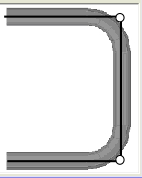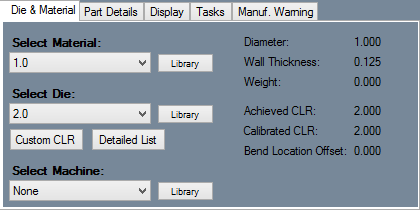Handrail Tutorial II
"UNDER CONSTRUCTION: THANK YOU FOR YOUR PATIENCE"
See Handrail Module and Handrail Tutorial for initial and secondary assistance regarding the Handrail Module.
Railing Design
- This tutorial will begin by showing how to create a length of railing designed with "PickPoints".
- For this reason, the default walls, platforms and steps will all be used. (please note that these features can be easily altered to fit the user's needs after they are placed in the display area.)
- "If you're not familiar with this interface, it is suggested that you visit the Handrail Module page for better understanding of the basics."
Things To Know
- "This tutorial is designed to walk the user through creating a Handrail design. As you go through this tutorial, later procedures will assume that you understand all earlier procedures. Because of this, it is very important that you carefully step through this guide, understanding everything along the way and following all steps in order."
- "A few key items need to be addressed before starting the step-by-step instructions of this tutorial. It is very important for Bend-Tech users to completely understand these items:"
- 1) PickPoints
- PICKPOINTS ARE USED FOR EVERYTHING. The Handrail part of the software is largely run in full 3D. Because a computer screen is only 2D, there is an unlimited amount of depth behind and in front of the cursor. A PickPoint is a point in 3D space that can be used for creating, editing, and placing parts in handrail design. PickPoints can be placed in a 2D environment by having their depth manually entered in the appropriate value fields.
- There are 2 types of PickPoints; Those automatically created by the part by default (various colors) and user-defined points (green). In addition, the initial (0,0,0) point is an automatic point that resides at the center of the Tri-Star. The Tri-Star is our directional definition locator.
- 2) Center Line & Apex
-
- Center Line: In the handrail design environment we are working exclusively with the "center-line" of a part, as compared to the inside or outside.
- Apex: Most bend locations are created in handrail design with the "Apex". Our definition of apex is the intersection of the straight tubes as if there wasn’t a radius.
- This is demonstrated in the picture below.
- 3) Locational Orientation
-
- Designing seems to work the best if users imagine as if they are standing at a 45 degree angle to the desired creation. This way left is left and right is right. Take a minute and examine the Tri-Star (under the PickPoints] tab) to get your orientation.
Start Up
1) Start by double clicking the "Bend-Tech 7x" icon to start up the program.2) Select the "Railing" icon ![]() in the Task Menu under the "Create New" section to open the Handrail Module interface. The window that opens should be labeled [Railing Design 1].
in the Task Menu under the "Create New" section to open the Handrail Module interface. The window that opens should be labeled [Railing Design 1].
3) For the purposes of this tutorial, click the "Maximize" button ![]() at the top right of the railing design window.
at the top right of the railing design window.
4) Also, for the purposes of this tutorial, zoom out significantly by spinning the wheel on your mouse so that the Tri-star is about the size of a pea in the lower left corner of the display area.
5) For the purposes of this tutorial. The "Die & Material" tab is located in the upper left corner of the window. Select the "1.00 Material" and "2.0 Die" as seen here.
Creating Walls
1) Select the "Walls" tab.
2) Select the blue "New" key![]() to create the first wall. The "Create New Wall" window will appear.
to create the first wall. The "Create New Wall" window will appear.
3) Type in "144" in the "Height" value field so that the dimensions of the wall will be 144 in. (12 ft.) high, 144 in. (12 ft.) long, and 6 in. wide. Click "OK".![]()
4) Next, change the "Offset" of the railing from the wall by typing in "5" in the "Offset" value field.
5) Move the cursor over to the display area. It will direct you to "Select the base point of the wall".
6) Place the wall at the "Tri-Star".
7) To create the next wall, select the same blue "New" key![]() as before. Change the "Height" to "144" as before when the "Create New Wall" window opens. Then, select the "Flip Wall" check box and change the direction of the wall by entering "90" in the bottom "Direction" field. This will change the direction in which the second wall faces by 90 degrees.
as before. Change the "Height" to "144" as before when the "Create New Wall" window opens. Then, select the "Flip Wall" check box and change the direction of the wall by entering "90" in the bottom "Direction" field. This will change the direction in which the second wall faces by 90 degrees.
8) In the display area, the wall will appear to intersect with the previous wall. Place this new wall at the far end of the first wall as shown in Fig 1.1
- Your screen should display the two walls as shown in Fig 1.2

